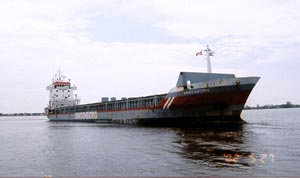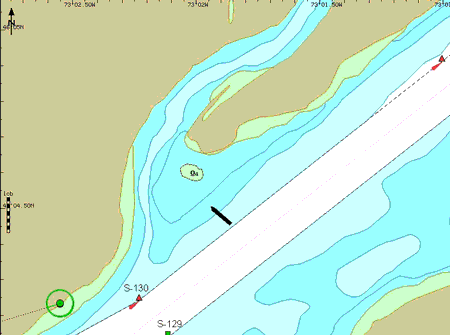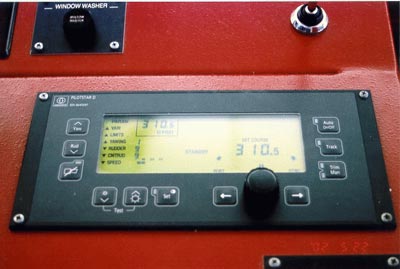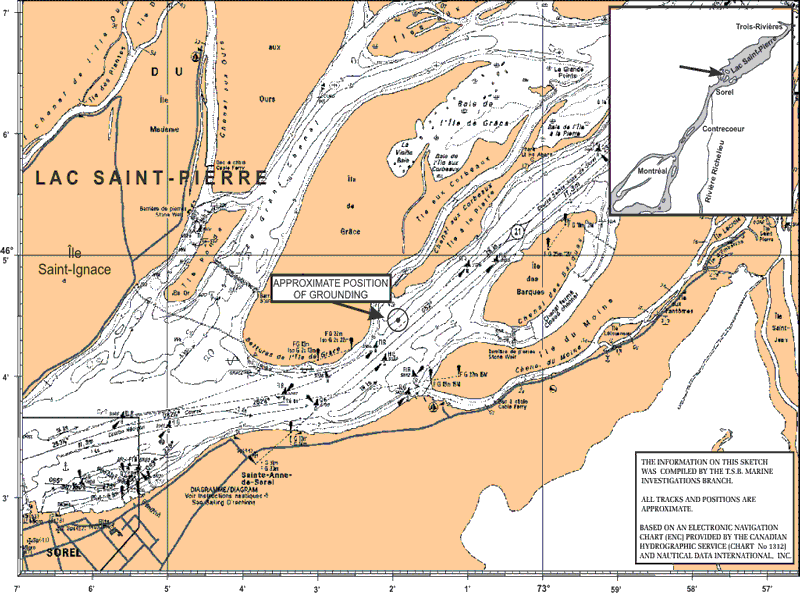Grounding
General cargo vessel Vaasaborg
off Île de Grâce, Quebec
The Transportation Safety Board of Canada (TSB) investigated this occurrence for the purpose of advancing transportation safety. It is not the function of the Board to assign fault or determine civil or criminal liability. This report is not created for use in the context of legal, disciplinary or other proceedings. See Ownership and use of content. Masculine pronouns and position titles may be used to signify all genders to comply with the Canadian Transportation Accident Investigation and Safety Board Act (S.C. 1989, c. 3).
Summary
In clear weather on 22 May 2002, the Vaasaborg was proceeding upbound in the St. Lawrence River, bound for Menominee, Michigan, United States.
The pilot had just reported that the vessel was at the calling-in point of Île des Barques when he noticed that the course remained unchanged after a course-set adjustment of one degree on the autopilot. When a second attempt was made by the pilot to alter the course, the bow was observed to sheer abruptly to starboard. Attempts to turn the helm to port were delayed. Full astern was ordered and the officer of the watch was tasked to let go the anchor. At 1005, the vessel ran aground on the north side of the channel off Île de Grâce.
Attempts to refloat the vessel were not successful until the vessel had been lightened, and on 29 May 2002, the Vaasaborg was refloated. No pollution, injury, or major damage resulted from this occurrence.
Factual information
Particulars of the vessel
| Name | "Vaasaborg" | |
|---|---|---|
| Official number | 6644 | |
| Port of registry | Delfzijl, Netherlands | |
| Flag | Netherlands | |
| Type | General cargo | |
| Gross tons | 6130 | |
| LengthFootnote 1 | 132.23 m | |
| Draught | Forward: 6.97 m | Aft: 7.05 m |
| Built | 2000, Bodewes Scheepswerf "Volharding" Foxhol B.V. Foxhol, Netherlands | |
| Propulsion | One Wartsila diesel engine developing 3960 kW, driving a controllable pitch propeller | |
| Cargo | 7997 metric tons of bleached pine and birch sulphate wood pulp | |
| Crew | 11 | |
| Owner | Wagenborg Shipping BV, Delfzijl, Netherlands | |
Description of the vessel
The Vaasaborg is a small general cargo vessel with two cargo holds forward of the accommodation. A mobile gantry crane on rails handles the hatch covers and other ship-related tasks. The machinery space and accommodation are located aft.
Description of the wheelhouse
The wheelhouse is located on top of the narrow accommodation superstructure. It is equipped with an integrated bridge system (IBS). There is a captain-style chair on each side of the central console. Each station has a radar monitor, but there is no electronic chart system (ECS) available. The central manoeuvring console has, among other controls, an echo sounder, two very high frequency radio units, an interphone control panel, a propelling machinery control panel, two remote steering control units, an autopilot control panel, and a remote override steering panel. The steering control and gyro pilot stand is located aft of this central console. There are four rudder angle indicators: one on the deckhead in the centre of the wheelhouse, one that is part of the autopilot display panel, and one on each of the bridge wings in way of the doors.
History of the voyage
On 06 May 2002, the Vaasaborg departed Kotka, Finland, with a cargo of wood pulp bound for Menominee, Michigan, United States.
On 22 May 2002 at 0755 eastern daylight time,Footnote 2 off the Pointe des Ormes pilot station, the Trois-Rivières-to-Montréal pilot boarded the vessel. On his way to the bridge, the disembarking Québec-to-Trois-Rivières pilot informed him that the gyro error was 4° low and that the vessel had a cruising speed of 14 knots.
Upon the pilot's arrival on the bridge, a pilot/master exchange was carried out, which included an understanding that the pilot would use the autopilot to steer the vessel. The master showed the pilot the basic functions of the autopilot, given that the pilot was unfamiliar with this particular model. More specifically, the master informed the pilot that the autopilot membrane keys inscribed with an arrow will change course 1° and the turn knob in the centre will make ½° changes. The pilot assumed the conduct of the vessel. He then put the engine-telegraph to full ahead and proceeded to pilot the vessel towards Montréal, Quebec, using the autopilot to steer the vessel.
When the vessel was approaching Île des Barques and near buoy S120, the pilot observed the Canadian Coast Guard Ship F.C.G. Smith carrying out soundings on the Sainte-Anne-de-Sorel course (232° True). In order to clear this vessel, the pilot manoeuvred the Vaasaborg to starboard towards the north side of the channel and, once clear of it, manoeuvred the vessel to port to come back to the centre of the channel. The vessel's position was reported to the Marine Communications and Traffic Services, at calling-in point No. 21, at approximately 0959. By observation of the Sainte-Anne-de-Sorel beacons, the pilot assessed that the vessel was slightly to the south of the centre of the channel. He attempted to adjust the course from 229° to 230°; the set course reading was observed to remain on 229°. He inadvertently activated the "Trim Man" control ("C") and activated the right arrow key once. However, the set course reading was observed to remain at 229°. At this time, the pilot pushed repeatedly on an autopilot membrane key and the vessel started to swing to starboard.
The pilot advised the officer of the watch (OOW) that the autopilot did not appear to be responding. The OOW then manipulated the autopilot controls to correct the situation, but without success. Thereafter, the OOW switched to hand steering control and started the second steering pump. By this time, the vessel had swung off course some 80° to starboard.
The pilot put the engine-telegraph astern. The master was in the ship's office and felt the vessel list to port. He immediately ran to the bridge. Upon his arrival, he saw the rudder angle indicator showing that the rudder was moving from hard-a-starboard to port; he put the engine-telegraph to zero (stop) and then astern. The master ordered the OOW to go to anchor stations. Notwithstanding these actions, at approximately 1005, at a speed over the ground of 11.6 knots, the vessel ran aground outside the north side of the channel, off Île de Grâce. The vessel came to rest in position 46°04′30″ N, 073°01′54″ W, on a heading of 310.5° Gyro (see Figure 1 and Appendix A).
Salvage operations
Several unsuccessful attempts were made to refloat the vessel with the assistance of tugs. On 30 May 2002, the vessel was refloated after unloading 1816 metric tons of cargo. The Vaasaborg proceeded down river to the port of Bécancour, Quebec, to undergo an underwater survey and to reload her cargo. No damage was apparent and, on 31 May 2002, she resumed her voyage to Menominee, Michigan, United States.
Autopilot control panel
The steering gear of the Vaasaborg can be controlled automatically by an Anschutz, Pilotstar D, Type AP01-S01, autopilot.Footnote 3 The main control panel is found on the central console near the starboard captain's chair. It is fitted with a liquid crystal display (LCD) screen, a membrane keyboard, and a rotary knob (see Photo 2). The LCD screen is divided into two logic fields of application (that is, a monitoring field on the left and an operating field on the right). In the monitoring field, a gyro-heading reading and several operational adjustment parameters are displayed. The operating field has a mimic indicator for off track and off course, a set course reading and a helm indicator with membrane keys (A, B, C, D and F) to select active mode, as well as a rotary knob (E) for set course preselection.
Function key "Auto On/Off" (A) activates the course control at cruising speeds.
Function key "Track" (B) activates the track control from way point to way point.
Function Key "Trim Man" (C) has a dual function:
When the key is pressed once, the autopilot system changes over to manual control. Course and track controls are deactivated. The rudder limitation (the number of degrees to which rudder movement is limited while in autopilot mode) is cancelled, and the rudder position reset to 0°.
In this mode, the rudder position (helm) is now set manually using the arrow keys (D and F) or the rotary knob (E). In other words, the system then behaves as a non-follow-up (NFU) unit.
When the key is pressed a second time, it will activate the course control/TRIM. In that mode, by using the rotary knob, a new course can be set. When using the arrows, the trim of the rudder can be preset to compensate for the drift effect or strong unbalance. However, according to the user manual, this should be done only when the vessel is proceeding at reduced speed.
Operation of the steering gear
The steering gear is an electro-hydraulic system composed of two rams and powered by two identical pump units. The rudder can attain an angle of 45° to port as well as to starboard, and can be steered with the autopilot from the bridge manually or automatically. Manual mode is accomplished by means of a follow-up (FU)Footnote 4 wheel, which is located at the steering control stand aft of the central console. For an NFUFootnote 5 operation, there are, on each side of the central console, two joysticks at remote steering control units. To override the remote control units in case of emergency, there is also a full-follow-up (FFU) joystick at the after part of the central console in way of the steering control stand.
Up until the time of the steering emergency, one pump unit was running the steering gear.
The autopilot was extensively tested after the occurrence and found to function normally. Prior to the occurrence, it had also functioned as designed.
Bridge complement
According to the International Convention on Standards of Training, Certification and Watchkeeping for Seafarers, 1978 (STCW), as amended in 1995:
- Administrations shall direct the attention of companies, masters, chief engineers, officers and all watchkeeping personnel to the requirements, principles and guidance set out in the STCW Code, which shall be observed to ensure that a safe continuous watch or watches appropriate to the prevailing circumstances and conditions are maintained in all seagoing ships at all times.Footnote 6
The STCW also stipulates that, "[t]he officer in charge of the navigational watch may be the sole lookout. . .," but:
-
The duties of the look-out and helmsman are separate and the helmsman shall not be considered to be the look-out while steering, except in small ships where an unobstructed all-round view is provided at the steering position and there is no impairment of night vision or other impediment to the keeping of a proper look-out.
When deciding the composition of the watch on the bridge, which may include appropriately qualified ratings, the following factors, inter alia, shall be taken into account:- any unusual demands on the navigational watch that may arise as a result of special operating circumstances.Footnote 7
The STCW does not specifically refer to additional personnel, as this is left to the discretion of the individual administration. The Wagenborg fleet manual stipulates that:Footnote 8
- The master is to ensure that the bridge is adequately manned for maintaining a safe navigational watch.
During daylight at sea, under normal conditions, only the officer of the watch on the bridge is usually considered sufficient.
In reduced visibility, in bad weather, when navigating in ice or congested or restricted waters and at all times during darkness, at least also a look out should be on the bridge, who can also take the helm in an emergency.
It is at the discretion of the master to increase the number of officers and rating on the bridge when he considers it necessary in the prevailing circumstances and conditions.
However, for a Canadian vessel of similar size, the requirements under sections 38, 39 and 40 of the Crewing Regulations are more specific, requiring two persons adequately trained for watchkeeping duties.In the case of the Vaasaborg, the OOW and the pilot formed the bridge team. The pilot made course alterations using the autopilot control. The master visited the bridge every so often. No helmsman was on duty.
Analysis
Sheer to starboard
Because the pilot sat in the starboard captain's chair at the IBS and the autopilot control panel is located on the starboard side of the central console, the pilot was the closest to this panel. It was therefore convenient for him to operate the autopilot when set course changes were required (that is, press the arrow-inscribed membrane keys). Without explicitly telling the pilot what to do, the master explained the basic operation of the autopilot, and the pilot assumed the role without further discussion. No helmsman was requested by the pilot, nor was the service of a helmsman offered by the master.On the Pilotstar D autopilot control panel, the "Auto On/Off," "Track" and "Trim Man" function membrane keys are identical in size and touch as the arrow (course alteration) keys. The proximity of the "Trim Man" function key to the starboard arrow key and the vessel's behaviour in the events leading up to the grounding suggest that the pilot inadvertently pushed the "Trim Man" key instead of the starboard arrow key, just prior to the vessel turning abruptly to starboard.By pushing this function key, the autopilot was deactivated, the system changed to manual control and to NFU mode. In manual and NFU mode, the set course reading is deactivated and the reading does not change. All further attempts to correct course to steer, using the arrow keys, were now actual rudder commands. The sequence of events indicates that the actions of the pilot to regain control of the rudder and steer 230° were in fact now causing the rudder to move increasingly to starboard. This is consistent with the vessel's rapid swing to starboard and would account for the 80° deviation of the course.The pilot's primary task was the conduct of the vessel. When the autopilot did not function as intended and the vessel developed a swing to starboard, it increased his workload. Given that his knowledge of the system was limited, when his scanning of the autopilot LCD screen did not provide him with the answer to what was happening, his attention became divided between the conduct of the vessel and the operation of the autopilot to regain control of the vessel. In other words, the swing to starboard prevented him from focussing more attention on why the autopilot did not function as expected.Generally, performance standards of modern equipment are excellent; however, if the operator does not comprehend the significance of the information available or presented, a potentially dangerous situation may develop.Footnote 9In today's marine environment, there are many manufacturers of navigation equipment worldwide. While, generally, there are performance standards governing how the equipment functions, the ergonomics and functionality of the equipment control systems are not standardized and there is no regulatory mandatory training to alleviate this problem.Being unfamiliar with this make of autopilot, the pilot did not understand why the vessel did not respond to his orders, and he was not able to correct the situation or to explain to the OOW what he had done to deactivate the system.
Emergency override steering system
Before the OOW switched to the follow-up mode at the steering station (wheel) and started a second steering pump, the OOW unsuccessfully tried to correct the situation with the autopilot controls. The OOW finally used the wheel at the steering control stand, but this action was carried out too late.In high-density traffic or restricted waterways, a steering gear failure or autopilot malfunction can be catastrophic. Sometimes it turns out that all that was necessary to avert the danger was a firm push at the correct moment on a simple control button.Footnote 10 It is necessary, therefore, for an OOW to be fully familiar with the onboard steering system, including all the controls. Only through training at regular intervals will the OOW maintain an understanding of the system and take immediate corrective action in an emergency. In this occurrence, the FFU joystick was not actuated to override the starboard helm command on the autopilot system.
Navigation equipment familiarization
The IBS has some similarities to pilot-copilot aircraft console arrangements. The navigation equipment is so arranged that controls are shared by the two operators. As only two people are involved in the operation, this model requires that the two navigators be duly qualified and familiar with the onboard navigation equipment.In comparison to aircraft pilots, who must follow simulator training to be proficient using a specific aircraft and its equipment, this type of training is neither available nor possible for navigators and marine pilots because of the non-standardization of navigation equipment. In this occurrence, the bridge team consisted of two professional mariners, who were expected to work as a team and conduct the vessel safely up the river. Both were qualified for the job to be done, but their equipment-familiarization training was less than adequate in the areas of basic operation and emergency override. As part of an overall training program, navigation equipment-familiarization training contributes to transportation safety.
Bridge crewing in pilotage waters and safety
The International Convention for the Safety of Life at Sea, 1974,Footnote 11 the International Safety Management Code (ISM Code), and the Code of Nautical Procedures and Practices all indicate that automatic steering should be switched to manual steering in sufficient time to allow for a potentially hazardous situation to be safely dealt with, particularly in areas of high-traffic density, restricted visibility, and other hazardous navigational situations.If the only persons on the bridge are the pilot and the OOW in restricted waters, the OOW would have to take over the steering manually, if necessary, thus depriving him of his primary role until a helmsman could be acquired. Similarly, if the pilot was involved in steering, he/she would be deviating from his/her principle functions. In this instance, none of the three ratings was called to perform steering duty. Given the crewing situation on the bridge and as requested by the master, the pilot undertook the task of steering the vessel by means of the autopilot. From a best-practice outlook, and given the level of automation, bridge ergonomics and the pilot's limited knowledge of this type of autopilot, it should not have been the duty or the obligation of the pilot to steer the ship using this equipment. "Despite the duties and obligations of a pilot, his presence on board does not relieve the master or officer in charge of the watch from their duties and obligations for the safety of the ship. . . ."Footnote 12 The duties of steering and the use/activation of the autopilot are responsibilities that should rest with a member of the crew who is familiar with the equipment and who can safely accomplish the task.The need to have the bridge adequately crewed for safe transit of a vessel has been recognized by the Canadian administration. For a Canadian vessel of a similar size, the composition of a deck watch under the Crewing Regulations is specific, requiring two persons adequately trained for watchkeeping duties. However, the STCW does not specifically refer to additional personnel, as this is left to the discretion of the individual Flag State administrations. Additionally, recognizing that prompt action may be required under certain circumstances, the services of a qualified helmsman are required at all times to take over steering control of a ship.Footnote 13 On a bridge, each navigation team member has specific duties to perform. Under normal operational circumstances at sea, when the autopilot is in use, the designated helmsman may carry out tasks other than steering. In a restricted waterway, however, the presence of the helmsman at the steering station is essential. This was not the case on board the Vaasaborg.
Use of steering gear power units
Although not a contributing factor to this occurrence, only one steering pump was in service when the autopilot was changed to manual control.Mariners should consider the importance of complying with the requirements of the International Convention for the Safety of Life At Sea (SOLAS), Regulation 19-1, Chapter V, which stipulate that:
- In areas where navigation demands special caution, ships shall have more than one steering gear power unit in operation when such units are capable of simultaneous operation.
Findings
Findings as to causes and contributing factors
- No crew member of the Vaasaborg was tasked to steer the vessel, and the pilot undertook to make course set alterations with the autopilot.
- In trying to change the set course, it is most likely that the pilot inadvertently first pushed the "Trim Man" function key instead of the starboard arrow (course alteration) key, thereby deactivating the autopilot and switching the system to the non-follow-up mode.
- When the pilot pressed the starboard arrow key, the helm gradually turned to hard-a-starboard, but the course set reading on the autopilot screen remained the same.
- By the time that the officer of the watch (OOW) switched the steering control to the follow-up mode at the steering stand, the vessel had commenced a rapid swing to starboard, from which it was not possible to recover before the vessel left the channel and ran aground.
- The OOW did not employ the emergency override steering system, which may have acted more quickly to correct the situation.
Findings as to risk
- The pilot had not acquired the proficiency and familiarity with the autopilot that was necessary to safely operate it in an emergency situation.
- At the time of the loss of steering, the OOW was not sufficiently familiar with the autopilot to employ the steering mode most likely to regain control.
- Although not a factor contributing to the occurrence, only one steering gear pump was in service while the vessel was operating in confined waters.
Safety action
Safety action taken
Transportation Safety Board of Canada
In August 2002, Marine Safety Information (MSI) letter 08/02 was forwarded to the Laurentian Pilotage Authority (LPA), the ship owners, the Netherlands Shipping Inspectorate, and a copy to Transport Canada, concerning duties performed by the pilot other than those normally carried out and the use of navigation equipment without proper training.
Laurentian Pilotage Authority
Upon receiving MSI 08/02, the LPA communicated with the Port of Montréal (District No.1.1) pilots and the two pilot corporations, i.e. Montréal-Québec (District No.1) and Québec-Les Escoumins (District No.2), recommending that the pilots not steer the vessel themselves using an autopilot, but instead request the services of a qualified helmsman. The LPA insists that a qualified deck watch officer and helmsman from the ship's complement be in the wheelhouse in compulsory pilotage waters to steer the vessel.
LPA Pilots and Pilot Corporations
The Port of Montréal pilots are employees of the LPA, and, therefore, their compliance to the LPA recommendations is implicit. The other two corporations, however, initially responded with reservations to the LPA recommendation. After several exchanges of correspondence, in May 2004, the Corporation des pilotes du Saint-Laurent central (District No.1) acknowledged the LPA recommendation by advising its pilots to conform to the recommendation concerning the manipulating of autopilot controls and the presence of a helmsman in the wheelhouse.
This report concludes the Transportation Safety Board's investigation into this occurrence. Consequently, the Board authorized the release of this report on .



